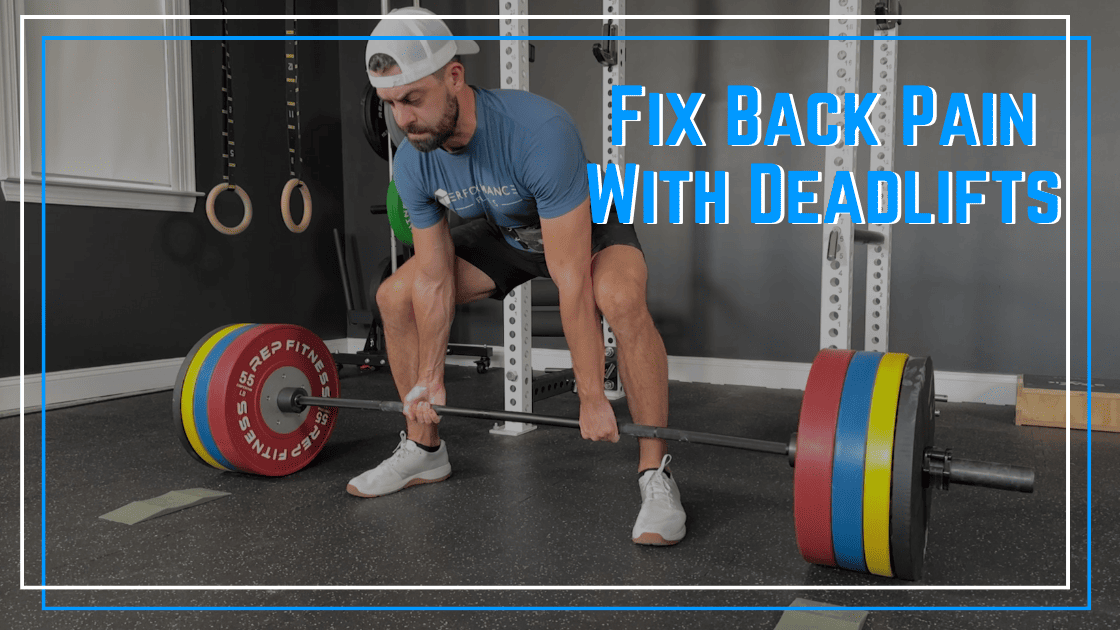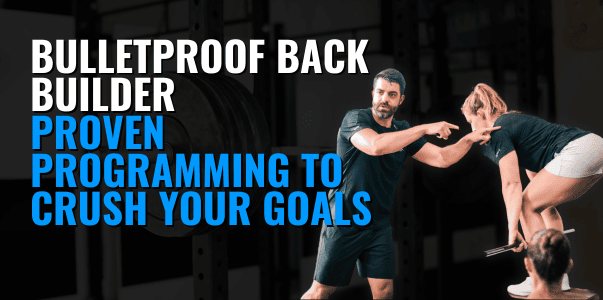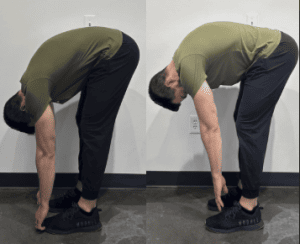The deadlift is one of the best exercises for improving whole-body strength. Hamstrings, glutes, spinal erectors, traps, and grip strength all in one! But for many athletes, every deadlift workout leaves them with an aching back or, worse, makes them avoid the movement altogether. This video will cover the most common technique issues to address if you are trying to fix back pain with deadlifts.
Fix Back Pain with Deadlifts
A number of different factors can contribute to back pain with deadlifts: training volume errors, poor recovery, technique issues, nerve tension, strength imbalances, and more. In this video, Doctor of Physical Therapy, Zach Long, breaks out the most common deadlift technique issues that contribute to back pain with deadlifts. If you want to fix back pain with deadlifts then make sure you aren’t making any of these deadlift mistakes!
Our Bulletproof Back Builder program is a great accessory plan for fitness athletes dealing with recurring back issues. It will build back strength up to help reduce strain and increase your strength.
Related Articles:
- Treating Back Pain with Deadlifts
- Returning to Deadlifts After Low Back Pain
- The Best Low Back Strength Exercises
- Strength Ratios
Fix Back Pain with Deadlifts Transcript
Spinal Bracing
The first reason why I see people struggle with deadlifts related low back pain is that they don’t know how to properly brace their spine.
So we want to think of your spine as like a water bottle versus a soda can. A soda can is stiffer; it’s going to be better able to tolerate having force applied to it. Bracing involves taking a big breath into the belly and tightening the abs. This action creates more pressure inside the intraabdominal cavity, allowing for better spine stiffness and increased stability.
When preparing to perform a deadlift, take a deep breath before initiating the movement. Imagine expanding your belly, filling it with air, and then tightening the abdominal muscles as if you are preparing to take a punch. This bracing technique provides a solid platform for your spine to maintain stability throughout the lift.
Another key point is to maintain this bracing technique throughout the entire lift. It’s common for lifters to relax their core and lose tension as they lift the weight. Remember to keep tight from the start to finish.
Take the Slack Out of the Bar
One important aspect that often gets overlooked is pulling the slack out of the bar. This is an essential step to prevent jerking and maintain proper positioning throughout your lift.
When you approach the bar, you may notice a slight wiggle or bend before you start the lift. This is the slack in the bar. If you were to immediately pull with full force, the bar would jerk and you would lose control. By slowly lifting the bar off the ground, you remove this wiggle and bend, ensuring a solid starting position.
By taking the time to pull the slack out of the bar, you establish tension in your muscles and maintain a controlled movement. It’s important to note that pulling the slack out of the bar is not about lifting slowly. It’s about initiating the movement in a controlled manner to set yourself up for success. Once the slack is removed, you can explode with force and drive the weight up.
When you approach the bar, you may notice a slight wiggle or bend before you start the lift. This is the slack in the bar. If you were to immediately pull with full force, the bar would jerk and you would lose control. By slowly lifting the bar off the ground, you remove this wiggle and bend, ensuring a solid starting position.
Engage Your Lats
Engaging the lats is essential for a safe and effective lift. By activating these large muscles in your back, you can reduce stress on your low back and improve your overall positioning during the lift.
One way to engage the lats is by pulling the shoulder blades down towards the back pocket. This movement helps to stabilize your upper body and create a solid foundation for the lift. Imagine squeezing your shoulder blades together and down as if you are trying to hold a pencil between them.
Another important aspect of engaging the lats is keeping the bar close to your body. This not only improves your positioning but also allows you to generate more power during the lift. By keeping the barbell in close proximity to your body, you create a shorter lever arm which minimizes the stress on your low back.
When engaging the lats, it’s important to focus on maintaining tension throughout the lift. This means that you should actively think about squeezing your lats throughout the entire movement. By doing so, you’ll not only protect your low back but also enhance your overall performance.
Deadlift Leg Drive
A strong leg drive is crucial in initiating the deadlift. It is the foundation of a successful lift and one of the key areas where lifters often struggle. By engaging the legs effectively, you can generate power and momentum, leading to better performance and reduced risk of injury.
When performing a deadlift, the leg drive is responsible for providing the initial force to lift the weight off the ground. By pushing through the floor with your legs, you activate the large muscles in your legs. This leg drive creates a solid base of support and provides a strong upward force to move the bar.
Additionally, by focusing on pressing through the floor, you can prevent a stripper pull. A stripper pull is when the hips rise faster than the chest, causing the lifter to lean back excessively and pull the bar away from the body. This improper technique not only reduces the effectiveness of the lift but also increases the risk of lower back strain or injury.
Keeping the bar close to the body is another significant benefit of using leg drive. When you activate your legs and push through the floor, you are naturally pushing the bar towards your body. This proximity provides better leverage and control over the weight, making the lift more efficient and reducing the risk of the bar drifting away from the optimal lifting path.
Stiff Lumbar Flexion
Next thing, and I have to say that like stereotypically, like where I see this in my physical therapy practice is my 40 to 50 year old men and that’s the stiff low back trying to deadlift. So what I like to look at is when somebody bends forward and reaches towards their toes, do they get flexion throughout their entire spine?
I’ll see a lot of guys that as they flex, their upper back might round, but their low back stays completely locked in. into place, and so then when they go to deadlift, even though they’re maintaining what looks like a neutral spine they’re at kind of their in range of their spine motion and the back just doesn’t like to have that much load on it at in range.
So some individuals with a really stiff low back would benefit from doing more cat/cows, Jefferson curls and exercises to open up a little bit of spinal flexion so that they can then deadlift in a true neutral versus neutral end range.
Low Back Strength
So the final piece of the equation here is an individual whose low back is just not strong enough. The deadlift does require a lot of low back strength. There are two kinds of ways that I might diagnose if somebody’s low back is just not strong enough.
Number one is I’m going to look at this Beiring Sorensen hold here. So Pamela has her torso parallel to the ground while she’s on a GHD. Her hands are at her chest, and if we find what’s called your ASIS, there is this little pointy bone on the front of your hips that’s almost just outside of your belly button, usually a little bit lower than that.
That’s right on the edge of the pad here, and she’s gonna simply hold that plank position. I like to see my athletes who are deadlifting have enough low back lumbar spine endurance that it could hold this for about two minutes is I think a good metric. If you can’t hold it for two minutes and this is also a fantastic accessory exercise to do to build that low back strength up.
Strength Test 2
The second thing that I use is looking at somebody’s back squat versus deadlift. Most people are gonna deadlift more than their back squat, and their back squats are going to be about 80 % of their maximum deadlift. If your back squat is much closer to your deadlift, maybe you deadlift 400 pounds, and you back squat 380 pounds far shy of 80 % or higher than 80%. Often, those are individuals with more muscular legs relative to the back. I will say a caveat, though, is that a lot of individuals with different body proportions might be stronger based on their body proportions, making that slightly less accurate of a test, but it can be a good starting point for some of you to identify if your low back just needs a little bit more strength. So there we have it. Six different things to look at if you struggle with deadlift-related low back pain.
We do have a great program if you follow into the category of somebody needing to build more low back strength, and that is our Bulletproof Back Builder at performanceplusprogramming .com. That is an accessory program built for individuals needing to strengthen and bulletproof their spine so that they have better lifts and less pain.
So check that out at performanceplusprogramming .com.








